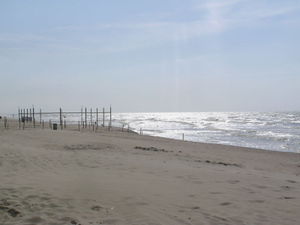Difference between revisions of "Sandy shores"
| Line 95: | Line 95: | ||
==Case-study Biodiversity patterns== | ==Case-study Biodiversity patterns== | ||
| − | A case-study about the latitudinal biodiversity patterns of meiofauna from sandy littoral beaches can be found [[Latitudinal biodiversity patterns of meiofauna|here]]. | + | A case-study about the latitudinal biodiversity patterns of meiofauna from sandy littoral beaches can be found [[Latitudinal biodiversity patterns of meiofauna from sandy littoral beaches|here]]. |
Revision as of 10:17, 25 July 2008
This article describes the habitat of the Sandy shores. It is one of the sub-categories within the section dealing with biodiversity of marine habitats and ecosystems.
Contents
Introduction
Sandy shores or beaches are loose deposits of sand, gravel or shells that cover the shoreline in many places. They make up two-thirds of the world’s ice-free coastlines. Beaches serve as buffer zones or shock absorbers that protect the coastline, sea cliffs or dunes from direct wave attack. It is an extremely dynamic environment where sand, water and air are always in motion. Beaches also provide important coastal recreational areas for a many people. Fine-grained sand beaches tend to be quite flat.

Formation
Sandy beaches are soft shores that are formed by deposition of particles that have been carried by water currents from other areas. The transported material is in part derived from the erosion of shores, but the major part is derived from the land and transported by rivers to the sea. The two main types of beach material are quartz (=silica) sands of terrestrial origin and carbonate sands of marine origin. The carbonate sand is weathered from mollusk shells and skeletons of other animals. Other material includes heavy minerals, basalt (=volcanic origin) and feldspar.
Characteristics
The grain size of sand varies from very fine to very coarse. The particle diameter is shown in the table below.
| Generic Name | Particle Diameter (mm) |
|---|---|
| Very coarse | 1.0 to 2.0 |
| Coarse | 0.50 to 2.0 |
| Medium | 0.25 to 0.50 |
| Fine | 0.125 to 0.50 |
| Very Fine | 0.0625 to 0.125 |
Functioning and adaptations
The intertidal zone is covered part of the day by water and is part of the day exposed to air. High tides bring nutrients and food with it. When the tide retreats, waste products, eggs and larvae are taken. This causes changes for the organisms that live here. They have adapted to this changing environment, as seen on rocky shores.
Biota
The distribution and abundance of the sediment infauna is mostly controlled by complex interactions between the physicochemical and biological properties of the sediment. [2]
The physicochemical properties are:
- Grain size
- Water content
- Flushing rate of water through the sediment
- Oxidation-reduction state
- Dissolved oxygen
- Temperature
- Light
- Organic content
The biological properties are:
- Food availability and feeding activity
- Reproductive effects on dispersal and settlement
- Behavior that induces movement and aggregation
- Intraspecific competition
- Interspecific competition and competitive exclusion
- Predation effects
Most invertebrate phyla are represented on sandy beaches, either as interstitial forms or as members of the macrofauna [3]. The macrofaunal forms are by far the better known. Some of them are typical of intertidal sands and their surf zone, while others are more characteristic of sheltered sandbanks, sandy muds or estuaries and are less common on open beaches of pure sand [3].
Macrofauna
Macrofauna of the sandy beaches are often abundant and, in some cases, attain exceptionally high densities. Their main feature is the high degree of mobility displayed by all species. These animals may vary from a few mm to 20 cm in length. The macrofauna community consists of those organisms too large to move between the sand grains. The macrofauna of sandy beaches includes most major invertebrate taxa although it has been recognised that molluscs, crustaceans and polychaetes are the most important. There is a tendency for crustaceans to be more abundant on tropical sandy beaches or more exposed beaches and molluscs to be more abundant on less exposed and on temperate beaches although there are many exceptions of this and polychaetes are sometimes more abundant than either of these taxa. Generally crustaceans dominate the sands towards the upper tidal level and molluscs the lower down level [3]. Physical factors, primary wave action and particle size of the sand largely determine distribution and diversity of the invertebrate macrofauna of sandy beaches. Food input and surf-zone productivity may determinate the abundance population. Water movement is important parameter controlling macrofaunal distribution on beaches.
Meiofauna
In contrast to the wave-swept surface sand inhabited by most of the macrofauna, the interstitial system is truly three-dimensional, often having great vertical extent in the sand. The porous system averages about 40% of the total sediment volume. Its inhabitants include small metazoans forming the meiofauna, protozoans, bacteria and diatoms[3]. The meiofauna is defined as those metazoan animals passing undamaged though 0.5 to 1.0 mm sieves and trapped on 30 mm screens. On most beaches the interstitial fauna is rich and diverse, even exceeding the macrofauna in biomass in some cases[3]. The dominant taxa of sandy beach meiofauna are nematodes and harpacticoid copepod with other important groups including turbellarians, oligochaetes, gastrotrichs, ostracods and tardigdades.
Insects
Terrestrial insects and vertebrates are frequently ignored in accounts of sandy beaches. These animals are usually a conspicuous component of the ecosystem, often rivalling the aquatic macrofauna in terms of biomass and having a significant impact on the system with regard to predation and scavenging.
Case-study Biodiversity patterns
A case-study about the latitudinal biodiversity patterns of meiofauna from sandy littoral beaches can be found here.
Please note that others may also have edited the contents of this article.
|
Please note that others may also have edited the contents of this article.
|